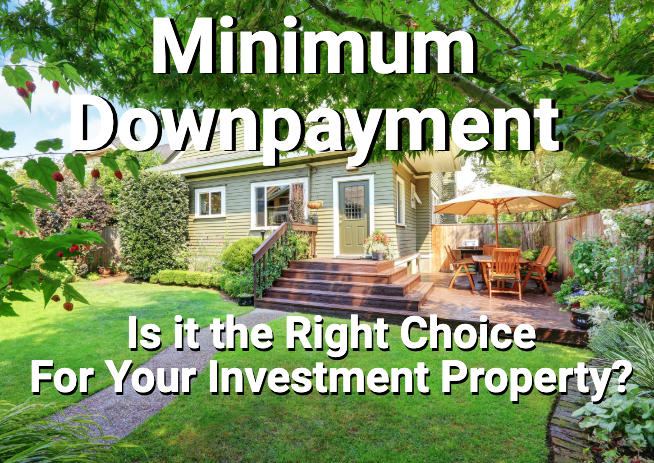You can find a variety of different strategies for purchasing an investment property. Some investors are committed to only buying properties using 100% cash; no loans and no mortgage payments. This is a good strategy for those who can afford it, but even people with the cash may prefer to use a minimum-downpayment loan, which allows you to keep a supply of cash on hand for different purposes.
If you are not sure which strategy is right for you, keep reading to learn about the advantages, as well as the potential risks, of using a minimum-downpayment loan for your next investment purchase.
Why a Minimum Downpayment Loan May Be Right for You
Note: San Diego Purchase Loans is NOT an investment strategist or financial expert in any way. Before making any decisions on your investments, always speak with a qualified professional.
Enter into Property-Ownership Faster
Many people avoid purchasing an investment property because they think the initial costs are too high. However, if you have a low downpayment, you may be able to purchase an income-generating property much faster.
If you have never purchased an investment property, you might think that it could be impossible to save for a sizable downpayment. After all, at 20%, you’ll need $20,000 for every $100,000 in purchase price. That means if you are buying a property at $400,000, you’ll need a downpayment of $80,000! That significant price can mean many people simply stay out of the investment-property market, and if they do enter, they will wait years, even decades. This lost time means lost money, as you could have spent those years building your portfolio.
With a lower downpayment, you can enter into property ownership much faster. With a few thousand dollars (depending on the purchase price, of course) you may be able to purchase a property and start building wealth, instead of spending years desperately trying to save for a downpayment. A low downpayment could allow you to purchase a property in just a couple years, or even a few months if you are able to aggressively save a few thousand dollars and find a low-cost home.
Remain Closer to the Purchase of Your Next Property
Using a downpayment reduces the amount of debt you have towards your property, but it also reduces the amount of money you have on hand; money that could be used for the purchase of another property.

What if you wanted to purchase a multi-unit investment property worth $500,000 and you have $100,000, which could be a 20% downpayment. With this money, you could reduce the amount borrowed on a single purchase, but what if you split the $100,000 into three or even four smaller downpayments? With this strategy, you could add more income-generating properties to your portfolio, significantly increasing your total holdings.
While this strategy needs to be done carefully, it could help you create a portfolio that brings rapid growth to your financial foundation.
Although it comes with higher risk and higher monthly payments, this could be a good strategy if your goal is to create a portfolio quickly. If you are able to organize and manage your money effectively, you could essentially use the same 30 years to purchase and pay off three or four units instead of one. When you decide to sell, you’ll have a larger base of properties that can be turned into liquid cash that can go towards your retirement. In the end, this could mean a more comfortable retirement.
Keep Capital for Repairs, Maintenance, and Upkeep
Ask any investor who has owned property for an extended period and they will inevitably discuss the expenses of owning property. Roofs need repair, foundations need sealing, refrigerators need replacement, and windows need installation. Not only that, but you will also have to deal with home maintenance, such as the replacement of filters and routine checkups on furnaces and air-conditioning units. There is also the regular upkeep, such as mowing the grass and trimming the bushes, not to mention cleaning the gutters, shampooing carpets, and countless other tasks. You’ll find that owning a home can come with many surprising (and unsurprising) costs, and managing these expenses can be more difficult than you may have thought.
The Downsides of a Minimum Downpayment
Of course, there are inherent risks to using a minimum-downpayment loan. With these types of loans, you are borrowing more money, so you will have to pay more in total interest on the loan. Essentially, the costs of borrowing money is higher, so you have to be prepared to deal with a larger total cost of homeownership. For example, if you use our mortgage calculator to find the total payments on a purchase of $400,000 using a 30-year loan with 4.25% interest and a 15% down payment ($60,000), we have a mortgage payment (interest and principle) of $1,673. At 360 monthly payments (30 years), that mean the total cost is $602,280.
However, if you only use a 3% downpayment ($12,000), you will have a monthly payment of $1,909. Assuming the same interest rate (which is not guaranteed), you have a total of $687,240.
So, by saving $48,000 at the start of the loan, the sum of the payments is $84,960 more.
In addition to the total money borrowed, you may also have to pay a higher interest rate, which could further increase the cost of borrowing money.
Also, you may find that qualifying for a loan is more difficult if you have less of a downpayment. This is especially true if you are looking for an investment property, as lenders prefer borrowers who can bring a substantial downpayment, reducing the statistical risk of a default.
Find a Minimum-Downpayment Loan That Fits Your Needs
If you want more information about the advantages of a minimum-downpayment loan, contact the helpful staff at San Diego Purchase Loans today. We’ll work with you to ensure you get the right service and support for your next home mortgage!


